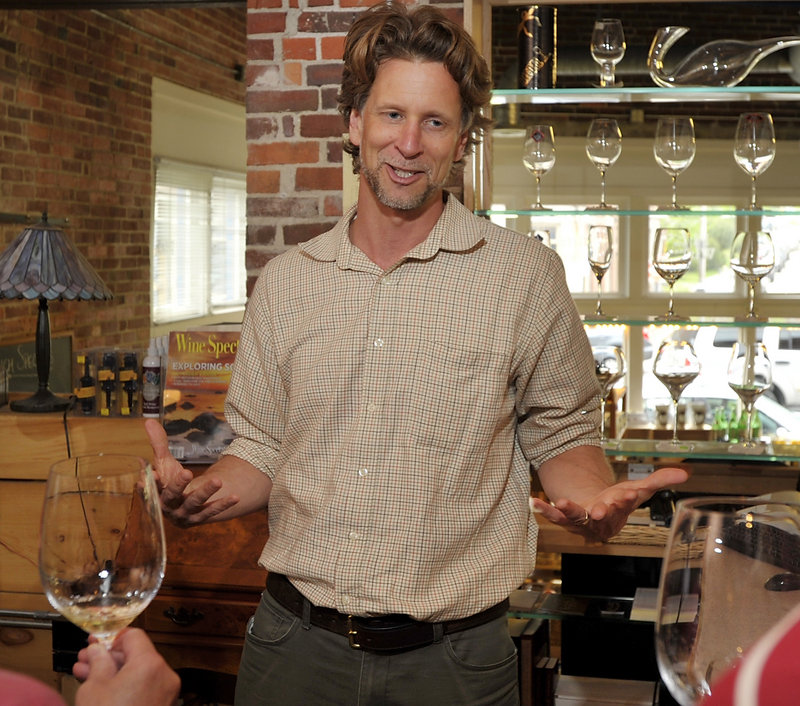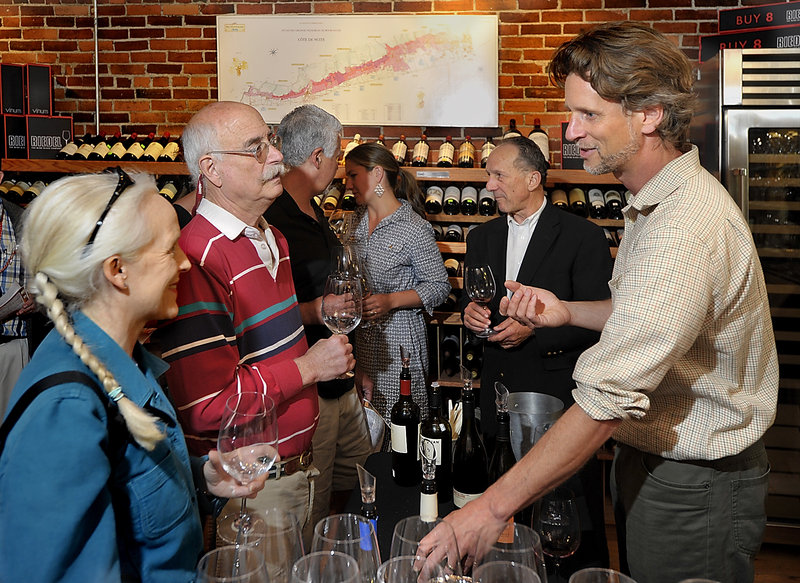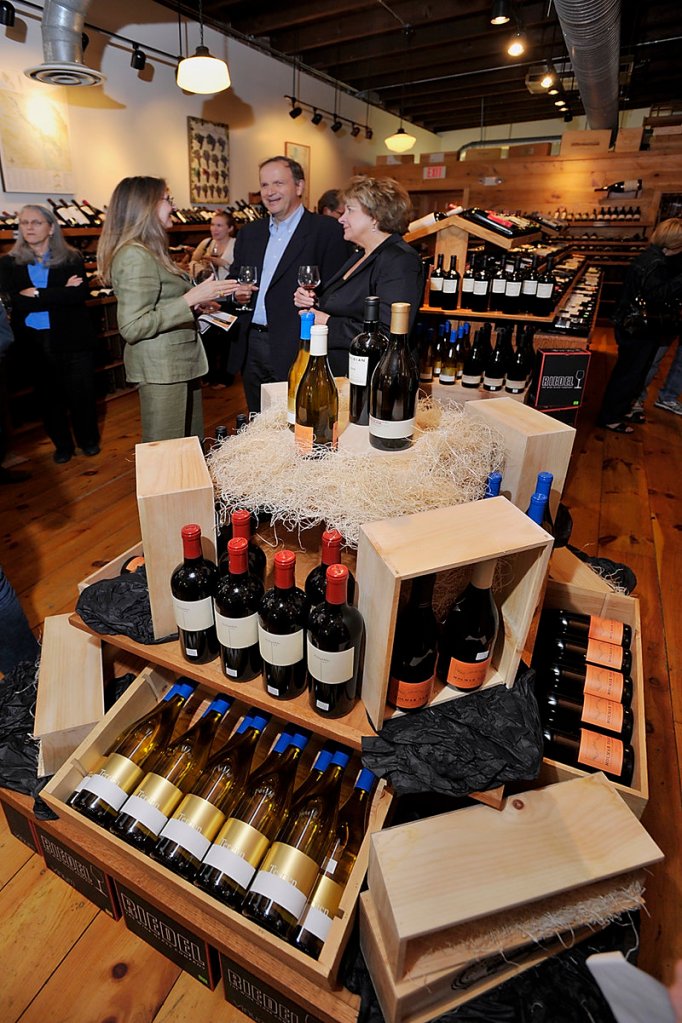Michael Terrien’s roots are right here in southern Maine.
The California winemaker flies back occasionally to visit family. But his last visit, in May, was special.
Terrien was in Portland to pour his 2007 Terrien Chardonnay at a wine-tasting at Browne Trading Co.’s retail market.
This isn’t just any chardonnay.
Food & Wine editor Ray Isle named it one of his five favorite wines of 2011, citing its “layers of flavor and distinctive floral aromas.”
Terrien Chardonnay is served in some of the finest restaurants in the country, including Thomas Keller’s Per Se and The French Laundry. It’s also on the wine lists at Daniel, Eleven Madison Park, Gilt and four other top New York restauarants.
In Maine, Terrien Chardonnay is served at Fore Street, Back Bay Grill, the White Barn Inn, Primo, Bresca and several other well-known restaurants.
So, who is Michael Terrien and why don’t you know his story?
Well, for one thing, Terrien admits he doesn’t get back to Maine as often as he’d like. Terrien, 44, lives in Napa with his wife, designer and photographer Hannah Henry, and their three children (another one was on the way at the time of our interview).
He’s also one of the founders, with Peter Molnar, of the Tricycle Wine Company, makers of Kazmer & Blaise, Obsidian Ridge and other brands. Add to that lots of consulting work at various California wineries and the creation of his own label, and Terrien is a busy man.
The winemaker’s trip to Maine in May was a special event because Browne Trading Co. is the only retail market in the country that sells his chardonnay. He plans to return later this month to begin a new project working with Maine blueberries – more on that later.
“I’m so impressed with Portland’s – and Maine’s in general – food scene,” Terrien said. “It’s just mind-boggling how the quality is way beyond what it should be for the population size.”
Terrien’s parents moved to Maine in 1967 as part of the back-to-the-land movement and settled in the Brunswick area. Terrien was less than a year old when they moved to Cape Elizabeth, where his mother still lives in the same home he grew up in.
“I was raised with, I wouldn’t say hippies, but they were of a mind to live off the land to the best extent,” Terrien said. “My mother is a weaver and did a lot of dying of wool, and my father an architect, and I just remember having to weed gardens and prune apple trees and grapevines, too, although not the kind you’d want to make wine out of.”
Terrien attended the Waynflete School in Portland, then headed off to Columbia University in New York to study philosophy and drink cheap wine. Between high school and college, he worked the 4:30 to 11 a.m. shift at the Portland Fish Exchange, slinging cod and haddock.
SWORDFISHING WITH GREENLAW
In the late 1980s, between semesters in college, Terrien landed a job swordfishing with Linda Greenlaw on the Gloria Dawn, years before the whole “Perfect Storm” phenomenon would thrust her into the public eye.
“She was willing to have a green guy get on the boat and help out,” Terrien said, “and I was absolutely thrilled with that, as a young man might be.”
Terrien became, he says jokingly, “a philosophy major with a fishing problem,” and eventually took an entire year off from school to go fishing. His interest in working on the sea led to a job with a fisheries observer program in Montauk, N.Y.
Terrien eventually headed west to California – not in search of wine country, but to study and start a career in marine sciences. To support himself, he worked in restaurants, most notably a gourmet pizza joint that served perhaps 30 wines. Terrien tasted them all, and enjoyed introducing his favorites to his customers.
It was there he was “sidetracked into wine,” driving an hour north to ask winemakers for mentoring and advice. People like Dennis Johns, who was working for St. Clement Vineyards in the Napa Valley at the time, took him under his wing and showed him how to make wine.
For a fundamental education in winemaking, Terrien entered the University of California-Davis, where he earned a masters in oenology. At the time it was a tiny program, with just seven other students.
“It’s an education in the scientific principles and the scientific method, but it doesn’t necessarily teach you how to make wine,” Terrien explained. “You really need to learn it from a mentor on the job. But what I gained from that education at Davis was an appreciation for the empirical method.
“And this is, I think, in service of quality winemaking wherever you are and whatever your educational background might be. If you can gather the evidence and draw logical conclusions from your palate and the methods that you apply, then quality improvements will come as you become more knowledgable. Because you don’t have a whole lot of shots at this. There’s probably only 30 or 40 vintages, and it’s one shot each year to make a good wine. Maybe you make a dozen wines at your winery, or maybe you only make one, but it’s a limited number of opportunties to figure it out before you die.”
After graduation, Terrien went to work as a harvest intern at Acacia Winery in Davis. He learned on the job and worked his way up to general manager. Acacia is a good-sized producer of pinot noir and chardonnay, and it was there that Terrien was able to apply his education and run commercial-scale experiments – using different maceration techniques, for example, or allowing yeast to ferment at a higher temperature to see how that affects the extraction of the tannins and color from the skins.
“All of those experiments had a profound influence on how I understand winemaking, and to have that latitude in the larger scale that Acacia provided was a great way to begin,” Terrien said.
Wine Spectator rated Terrien’s Acacia Pinot Noir among the top 100 wines in the world.
IN A DIFFERENT DIRECTION
From there, in 2005, Terrien went to the other end of the spectrum, working at a small, highly respected pinot noir and chardonnay producer called Hanzell. Bob Sessions had been the winemaker and general manager there for more than 30 years. Terrien learned from him the Hanzell approach of making a California chardonnay that is reminiscent of a white burgundy and that has potential for aging.
“This is one of most most respected and vaunted producers of old-style pinot noir and chardonnay in California,” Terrien said. “The vines there date back to 1953, which is the oldest pinot noir and chardonnay vines in California. There’s younger vines, too, but the reputation Hanzell established is well-deserved, and it’s predicated on techniques that were developed back in the infancy of the California wine industry. So the methods were in service to the ideal of truly grand cru-level red and white burgundy, and that means ageability is critically important to those wines, whereas a more commercial winery such as Acacia is interested in producing a wine which tastes delicious early on in its life. Hanzell deserves to be aged in your cellar for a decade or longer to realize its full potential.”
Terrien used Hanzell grapes and some of the methods he’d learned at the winery to make his 2007 Terrien Chardonnay. The result is unlike any other California chardonnay.
Terrien used no malolactic fermentation, which gives other California chardonnays their buttery characteristics, in his wine. He made 300 cases and put them in his cellar for three years so the bottles could begin to develop more nuanced characteristics.
“This is something that you take for granted when you buy a bottle of white burgundy,” Terrien explained. “You know that it should not be opened until you’ve aged it for some time, to really realize its full potential. But being from California and defying expectations with this style, I made the decision to invest that time in my cellar rather than your cellar, so that when you open that bottle now you can see what it has become and what its potential is for further development. I think this is a 15-year-wine. That’s unusual for California chardonnay.”
People who prefer oakey, buttery chardonnays will be disappointed.
“This is a wine made for me with the character and personality and soul that I really look for in great white burgundy,” he said. “That’s not to say that I’ve successfully emulated a great white burgundy; it’s to say that that’s my guiding principle in making this wine.”
A grand cru white burgundy by Hanzell might sell for $75 a bottle. The Terrien chardonnay is more like a village white burgundy, and that’s reflected in its more humble price. Browne Trading Co. sells it for $37 a bottle.
Terrien is thrilled that the wine has gotten noticed by sommeliers at some of the top restaurants in the country.
“The acidity’s higher, and acidity is so critically important to the palate when you’re eating,” Terrien said. “It seems to be the humble wines that work best with the cuisines in a fine restaurant. So the sommeliers’ appreciation for this style of wine has been nothing short of astonishing. There’s nothing more gratifying than to find an audience for it who appreciates what I’m pursuing, and that’s been very special.”
Terrien said he doesn’t plan to make anything other than chardonnay under his own label. However, he is working with other vineyards to forge long-term relationships that will allow him to pursue higher-quality wines using similar techniques – even at the premiere cru and grand cru levels.
Terrien is always experimenting, and his next experiment will take place right here in Maine.
“It occurred to me to try to create an extra reason to return to Maine and begin making a blueberry amaro,” he said.
An amaro (the Italian word for bitter) is a liqueur served as an aperitif.
Terrien has already started talking with Keith Bodine of Sweetgrass Winery in Union (the maker of Back River Gin) about getting some help with the project.
Until then, there’s Terrien Chardonnay – a crisp wine for summer that sports a range of subtle flavors and a nice long finish.
Enjoy.
Staff Writer Meredith Goad can be contacted at 791-6332 or at: mgoad@pressherald.com
Twitter: Meredith Goad
Send questions/comments to the editors.






Success. Please wait for the page to reload. If the page does not reload within 5 seconds, please refresh the page.
Enter your email and password to access comments.
Hi, to comment on stories you must . This profile is in addition to your subscription and website login.
Already have a commenting profile? .
Invalid username/password.
Please check your email to confirm and complete your registration.
Only subscribers are eligible to post comments. Please subscribe or login first for digital access. Here’s why.
Use the form below to reset your password. When you've submitted your account email, we will send an email with a reset code.